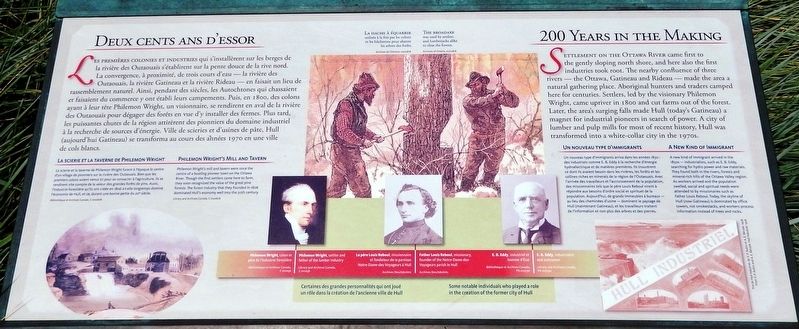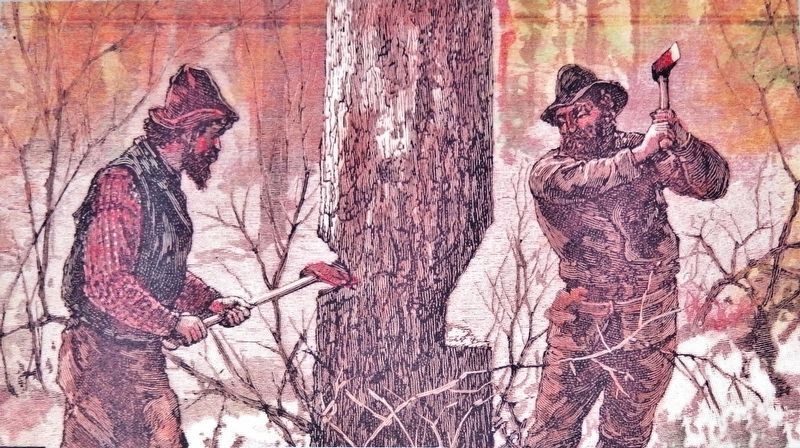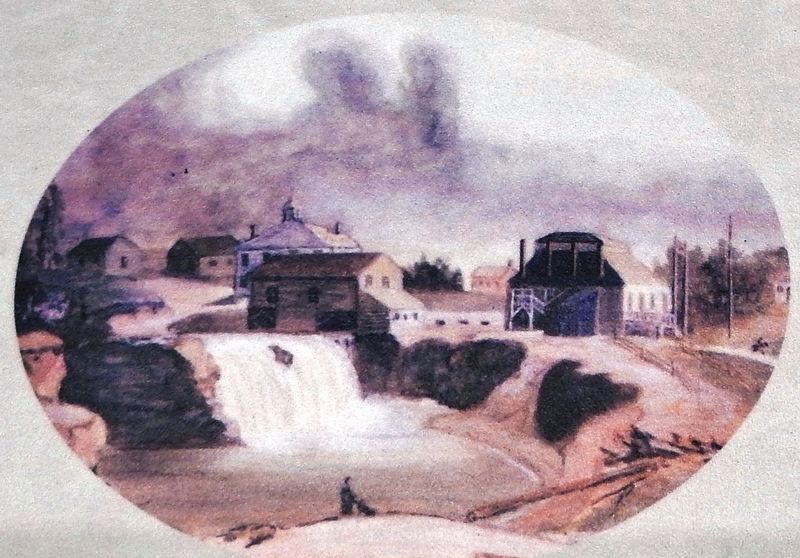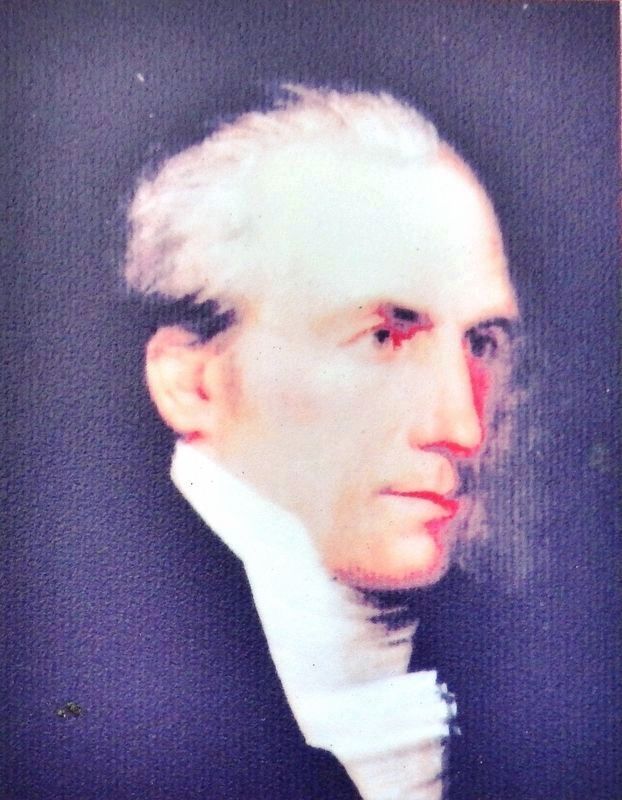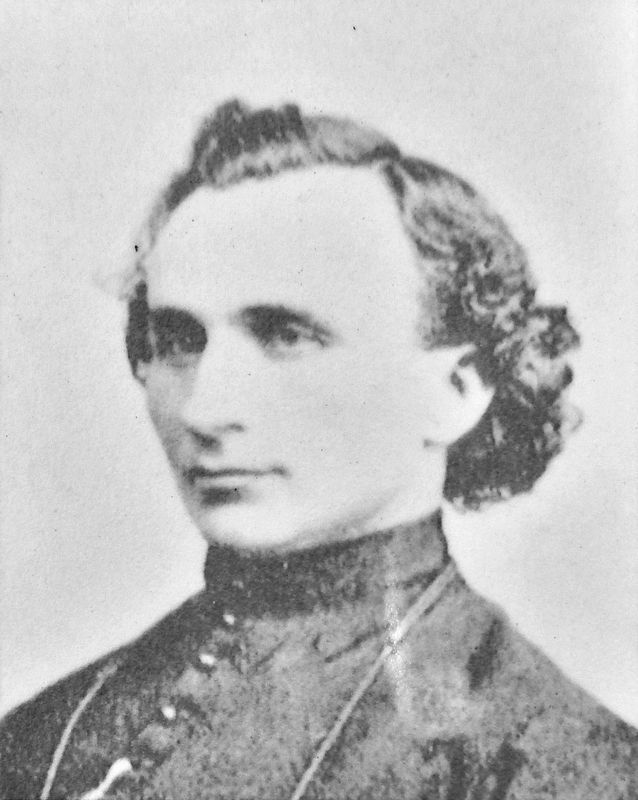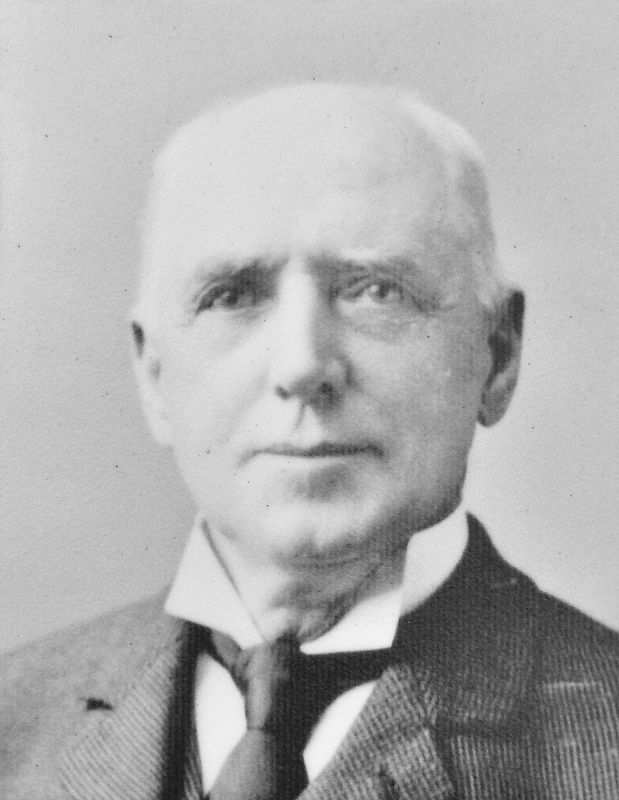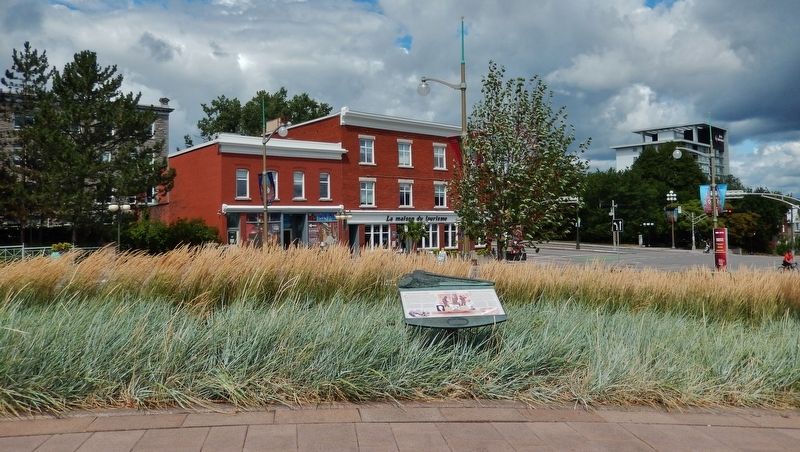Gatineau in Communauté-Urbaine-de-l'Outaouais, Québec — Central Canada (French-Canadian)
Deux cents ans d'essor / 200 Years in the Making
Inscription.
Les premières colonies et industries s'installèrent sur les berges de la rivière des Outaouais s'établirent sur la pente douce de la rive nord. La convergence, à proximité, de trois cours d'eau — la rivière des Outaouais, la rivière Gatineau et la rivière Rideau — en faisait un lieu de rassemblement naturel. Ainsi, pendant des siècles, les Autochtones qui chassaient et faisaient du commerce y ont établi leurs campements. Puis, en 1800, des colons ayant à leur tête Philemon Wright, un visionnaire, se rendirent en aval de la rivière des Outaouais pour dégager des forêts en vue d'y installer des fermes. Plus tard, les puissantes chutes de la région attirèrent des pionniers du domaine industriel à la recherche de sources d'énergie. Ville de scieries et d'usines de pâte, Hull (aujourd'hui Gatineau) se transforma au cours des années 1970 en une ville de cols blancs.
La scierie et la taverne de Philemon Wright
La scierie et la taverne de Philemon Wright furent à l'époque le centre d'un village de pionniers sur la rivière des Outaouais. Bien que les premiers colons soient venus ici pour se consacrer à l'agriculture, ils se rendirent vite compte de la valeur des grandes forêts de pins. Aussi, l'industrie forestière qu'ils ont créée en 1806 a-t-elle longtemps dominé l'économie de Hull, et ce, durant une bonne partie du 20e siècle.
Un nouveau type d'immigrants
Un nouveau type d'immigrants arriva dans les années 1850 : des industriels comme E. B. Eddy à la recherche d'énergie hydroélectrique et de matières premières. Ils trouvèrent ce dont ils avaient besoin dans les rivières, les forêts et les collines riches en minerais de la région de l'Outaouais. Avec l'arrivée des travailleurs et l'accroissement de ta population, des missionnaires tels que le père Louis Reboul virent à répondre aux besoins d'ordre social et spirituel de la population. Aujourd'hui, de grands immeubles à bureaux —au lieu des cheminées d'usine — dominent le paysage de Hull (maintenant Gatineau), et les travailleurs traitent de l’information et non plus des arbres et des pierres.
Certaines des grandes personnalités qui ont joué un rôle dans la création de l'ancienne ville de Hull : Philemon Wright, Le père Louis Reboul et E. B. Eddy.
Settlement on the Ottawa River came first to the gently sloping north shore, and here also the first industries took root. The nearby confluence of three rivers — the Ottawa, Gatineau and Rideau — made the area a
natural gathering place. Aboriginal hunters and traders camped here for centuries. Settlers, led by the visionary Philemon Wright, came upriver in 1800 and cut farms out of the forest. Later, the area's surging falls made Hull (today's Gatineau) a magnet for industrial pioneers in search of power. A city of lumber and pulp mills for most of recent history, Hull was transformed into a white-collar city in the 1970s.
Philemon Wright's Mill and Tavern
Philemon Wright's mill and tavern were once the centre of a bustling pioneer town on the Ottawa River. Though the first settlers came here to farm, they soon recognized the value of the great pine forests. The forest industry that they founded in 1806 dominated Hull's economy well into the 20th century.
A New Kind of Immigrant
A new kind of immigrant arrived in the 1850s — industrialists, such as E. B. Eddy, searching for hydro power and raw materials. They found both in the rivers, forests and mineral-rich hills of the Ottawa Valley region. As workers arrived and the population swelled, social and spiritual needs were attended to by missionaries such as Father Louis Reboul. Today, the skyline of Hull (now Gatineau) is dominated by office towers, not smokestacks, and workers process information instead of trees and rocks.
Some notable individuals who played a role in the creation of the former
city of Hull: Philemon Wright, Father Louis Reboul and E. B. Eddy.
Erected by The National Capital Commission / La Commission de la capitale nationale.
Topics. This historical marker is listed in these topic lists: Industry & Commerce • Settlements & Settlers • Waterways & Vessels. A significant historical year for this entry is 1800.
Location. 45° 25.895′ N, 75° 42.572′ W. Marker is in Gatineau, Québec, in Communauté-Urbaine-de-l'Outaouais. Marker is at the intersection of Laurier Street and Alexandra Bridge (Boulevard des Allumettières), on the right when traveling north on Laurier Street. Marker is located beside the walkway at the southeast corner of the intersection. Touch for map. Marker is in this post office area: Gatineau QC J8X 3V8, Canada. Touch for directions.
Other nearby markers. At least 8 other markers are within walking distance of this marker. Le Parlement du Canada / Canada's Parliament (about 240 meters away, measured in a direct line); La Tour de Lessivage / The Digester Tower (approx. 0.4 kilometers away); Alexandra (Interprovincial) Bridge / Pont Alexandra (Interprovincial) (approx. 0.6 kilometers away in Ontario); Alexandra Bridge (Interprovincial) / Pont Alexandra (Interprovincial) (approx. 0.6 kilometers away in Ontario); People at an Ancient Crossroads / Un ancien point de jonction (approx. 0.6 kilometers
away in Ontario); Wilderness Highway / Une route au beau milieu de la nature (approx. 0.7 kilometers away in Ontario); Building for a New Canada / Construire un nouveau Canada (approx. 0.7 kilometers away in Ontario); The Royal Canadian Mint / La Monnaie Royale Canadienne (approx. 0.8 kilometers away in Ontario). Touch for a list and map of all markers in Gatineau.
Related markers. Click here for a list of markers that are related to this marker. Confederation Boulevard / Boulevard de la Confédération
Also see . . .
1. Philemon Wright. The founder of Wrightstown (later Hull) and the man who initiated the Ottawa Valley timber trade, Wright came to Canada in 1800 as the leader of a small group from Massachusetts who settled at the present site of Hull. He intended to develop a community of independent farmers, but lack of income forced him into the timber trade in 1806 in order to provide cash for the settlement and a winter occupation. (Submitted on June 5, 2020, by Cosmos Mariner of Cape Canaveral, Florida.)
2. Louis Étienne Delille Reboul. In the winter of 1854, Father Reboul undertook his first mission in the loggers’ camps. He went as far as Deep River, Ontario, and
Black River, visiting the various camps of young men who were employed to cut the forests and providing them with access to religious practice. In summer the missionary visited these men again in the region of Ottawa. He became the leader of the team of missionaries to the camps in the Ottawa area in 1858 and Father Reboul continued this work for several months each winter until his death, which took place during one of his mission journeys. (Submitted on June 5, 2020, by Cosmos Mariner of Cape Canaveral, Florida.)
3. Ezra Butler Eddy and the pulp and paper industry. This practical and progressive man was the first Ottawa Valley lumberman to illuminate his mills with electricity in 1883, and to replace horses with trucks for transportation in the outlying areas around his factories in 1906. And in 1870, he had double railroad tracks laid for the train that crossed his property, linking his sawmills and factories with the lumber yards that stretched all along the shore of the Ottawa River. (Submitted on June 5, 2020, by Cosmos Mariner of Cape Canaveral, Florida.)
Credits. This page was last revised on January 23, 2022. It was originally submitted on June 3, 2020, by Cosmos Mariner of Cape Canaveral, Florida. This page has been viewed 120 times since then and 14 times this year. Photos: 1. submitted on June 4, 2020, by Cosmos Mariner of Cape Canaveral, Florida. 2, 3, 4, 5, 6, 7, 8. submitted on June 5, 2020, by Cosmos Mariner of Cape Canaveral, Florida.
